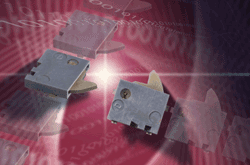C&K Components
Newton,MA
www.ck-components.com
Reducing footprints in mobile and consumer electronic devices is becoming a major challenge for component manufacturers. End products are getting smaller, and as a result, components must also follow suit. For switch manufacturers this often means developing innovative switch designs beyond standard miniature switches. Where previously a number of applications relied on miniature slide switch technology, these applications are now benefiting by using smaller, more flexible detect switch designs. This is particularly well suited for e-book readers, MP4 and video players, and mobile communication devices.

The size and versatility of detect switches make them ideal for applications in the high-actuation-cycle consumer market such as detecting the game card in gaming devices, activating displays, initiating action upon flipping the devices open, and powering on and off.
The advantage of detect switches over slide switches or pushbuttons is that they are smaller and more flexible by design while providing longer life spans, lower profiles, and increased versatility in the design of the actuator mechanism.
Life expectancy
Standard slide switches have a life cycle ranging from 10,000 to 30,000 actuations, while typical detect switches can reach a range of 100,000, which is much more suited to consumer applications. The contact mechanism in the detect switch is a key element to the extended lifespan, as it typically is composed of a cam mechanism that is compressed as opposed to a sliding mechanism which is at greater risk of wear and tear.
Additionally, OEM design engineers often design their own caps for the switches within their applications, with a built-in “stop” to prevent damage to the switch if the device is dropped or banged. While most detect switches are momentary action devices, detects serving as slide switches require a detent to keep them locked in place. This “bump” or “stop” creates enough flex in the plastic to lock the switch into the back side of the housing.
Low profile
Detect switches are also used for a power-down and power-up functions in MP4 and video players, e-books and multimedia phones. Such designs often require switches with extremely low profiles and footprints. A typical slide switch is about 10 mm long, but detects often measure less than 3 mm long. In terms of overall profile, some ultra-low-profile microminiature surface-mount detect switches measure only 5 x 4 mm with a pc-board height of just 0.9 mm, while others feature smaller body dimensions around 3 x 3.5 mm, but have a slightly taller board height of 1.4 mm.
Versatility in design
The variety of detect switch designs is paramount in their ability to meet the requirements of different applications. With variations from surface-mount and through-hole; to snap-in and snap-acting; to lever actuation and over-travel; and pendulum actuation designs with top, side, left, and right actuation; detect switches are being customized to meet any criteria, suiting them for any number of different consumer electronics, gaming and handheld devices. Additionally, some detects are also designed to be actuated in both the x and y axes, further maximizing versatility in a number of applications.
Because the time-to-market cycles of consumer products are relatively short, customers do not want to design custom components and be caught in long development cycles. As a result, switch manufacturers must offer detect solutions that are readily available off-the-shelf, making versatility in actuator styles and sizes all the more important.
Expanding beyond mobile and gaming devices
Detect switches functioning as slide switches are now being incorporated into other consumer devices as well, such as handheld gardening tools and even personal hygiene devices, because of their success in mobile and gaming electronics.
Switch manufacturers that offer standard detect models with a wide range of customization options including actuator styles, location, and size are at a distinct advantage for design wins in today’s consumer market because electrical and mechanical specifications in consumer applications are critical; tolerances are extremely tight; product profiles are small; development cycles and lead time requirements are short. ■
Advertisement
Learn more about C&K Components





